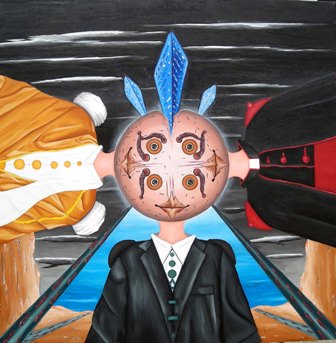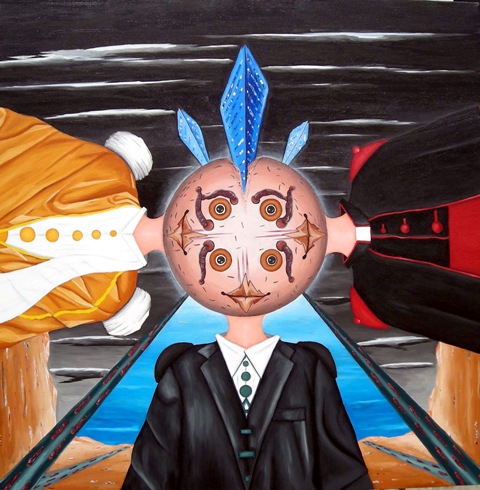
L’opera si presenta come una crocifissione antropomorfa in cui i bracci della croce sono costituiti da tre figure simbolo delle religioni del libro: il Cristianesimo, l’Ebraismo e l’Islam.
Tre uomini, un vescovo, un rabbino e un imām, si mostrano al riguardante con fierezza e austerità. Le loro teste si fondono al centro della tela e danno forma al mondo, di cui si alimentano, nutrendosi indisturbate, le sanguisughe.
Le figure si stagliano nitide, definite da un ductus affilato, come intagliate nella pietra dura.
Un particolare iconografico, i copricapi sulle spalle, alla maniera di mostrine indossate con orgoglio, ne assimila l’aspetto a quello di generali del moderno ordo militum Christi.
I tre personaggi sembrano trovarsi, come antichi custodi della Terra Sancta, per ripartire il mondo dilaniato da tre “grattanuvole”, svettanti come moderne croci martiriali, simbolo di antiche memorie del Golgota e degli eventi di cui è stato teatro.
La tela offre ampi spunti di riflessione: il carattere esclusivo ed universale delle tre confessioni; il confronto tra le “genti del libro”; l’opportunità di un rinnovato dialogo interreligioso; l’intelligenza della diversità presupposto essenziale di ogni forma di incontro; ma lo sfondo oscuro e incombente richiama nel contempo storie di conflitti, violenze, condanne, estromissioni ed occupazioni.
L’autore sembra domandare al suo pubblico se il monoteismo sia strumento di pace o di guerra.
In collezione privata
Monotheisms compared Pasquale-Mastrogiacomo
The work looks like a crucifixion in which anthropomorphic arms of the cross symbol consisting of three figures in the book of religions: Christianity, Judaism and Islam.
Three men, a bishop, a rabbi and an imam, was on the show with pride and austerity. Their heads are fused at the center of the canvas and shape the world, including feeding, undisturbed feeding, the leeches.
The figures stand out clear, defined by a sharp ductus, as carved in hard stone. A particular iconography, the headgear on his shoulders in the manner of badges worn with pride, it assimilates to that of the general appearance of the modern ordo militum Christi.
The three characters appear to be as ancient guardians of the Holy Land, to share the world torn by three “scratch clouds ” tall as modern martyrs crosses, a symbol of ancient memories and the events of Golgotha where he was the theater.
The canvas provides ample food for thought: the unique and universal character of the three faiths, comparing the “people of the book” an opportunity for renewed interreligious dialogue, the understanding of diversity are essential prerequisites for any form of meeting, but the background dark and looming draws stories of conflict, violence, convictions and predatory occupations.
The author seems to ask the audience if monotheism is an instrument of peace or war
